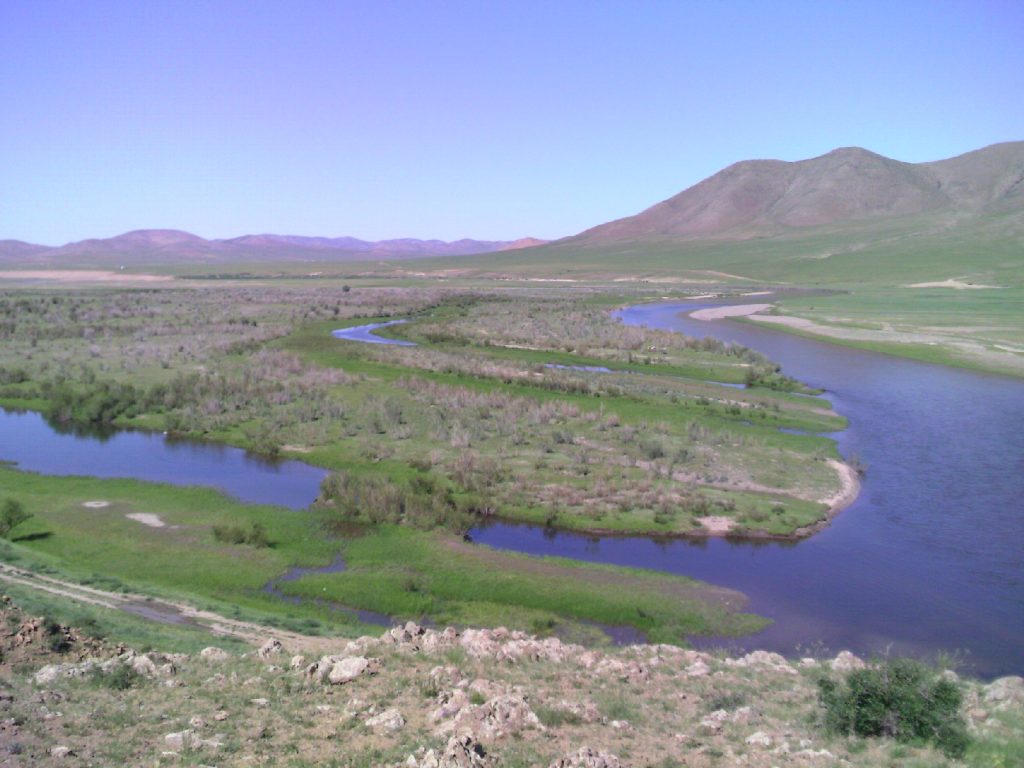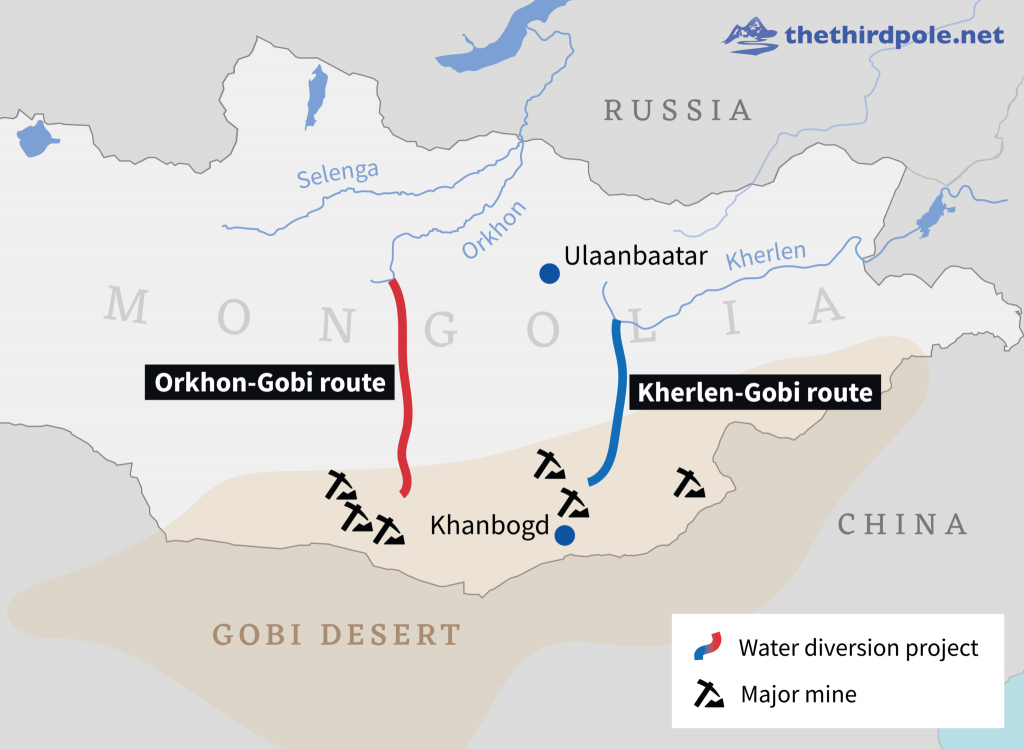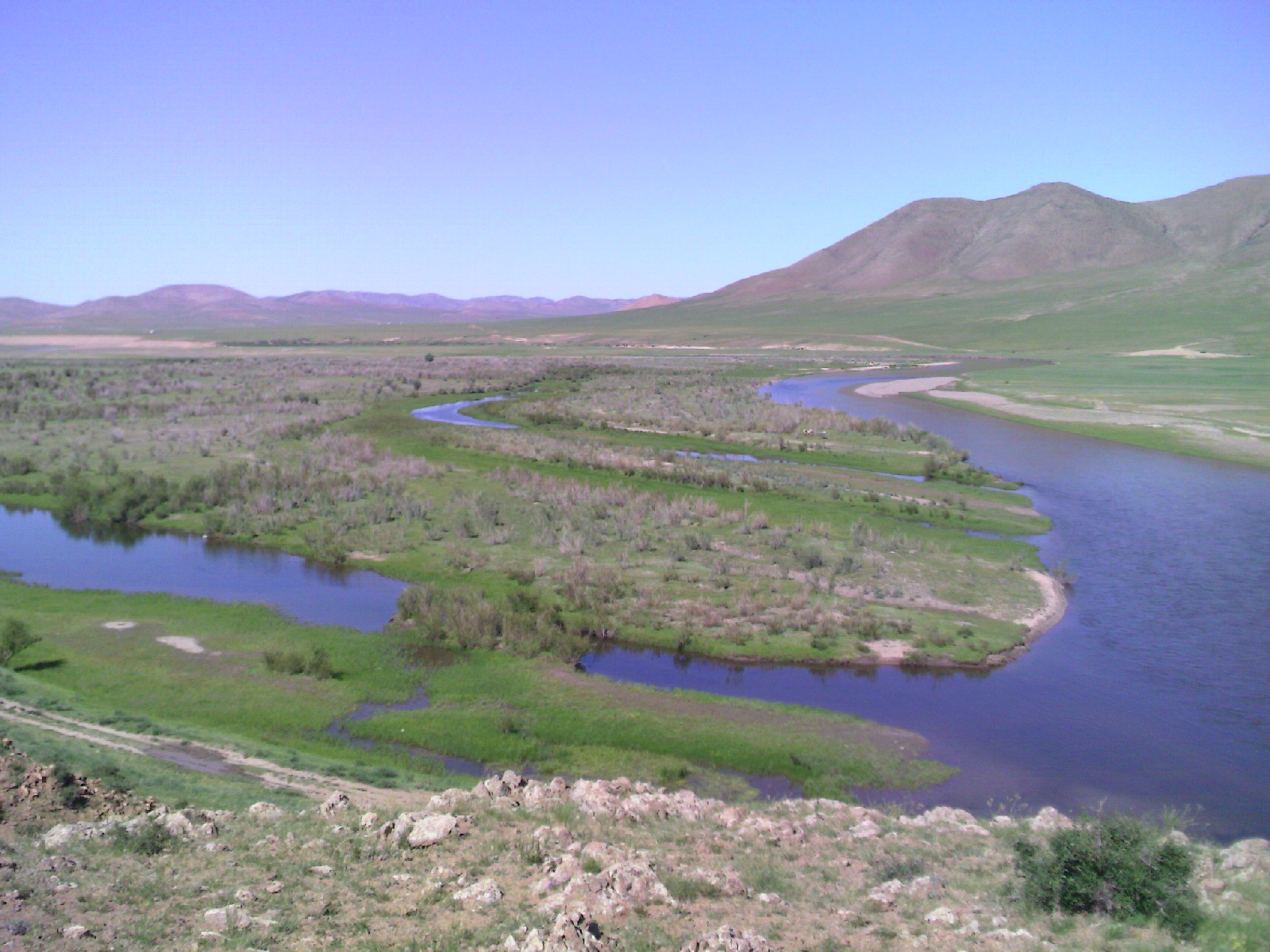
Before 2000 there were no mines in South Gobi apart from the state-run Tavan Tolgoi coal mine. But over the past two decades, foreign investment has flooded in, with companies now operating 12 large mines, including Rio Tinto’s Oyu Tolgoi, one of the world’s biggest copper and gold mines. Driven by the mining industry’s growing demands, the government estimates that the region’s groundwater will run dry within a few years.
Much of Mongolia’s water is in the north, and the government now plans to pipe this water to the arid south where the majority of the mining takes place, a ‘solution’ that has led to many more problems wherever it has been tried.
Meanwhile, the water shortage is critical enough to lead to violence. L. Battsengel, a herder in Khanbogd, a small town near the huge Oyu Tolgoi mine, told The Third Pole that many wells have dried up in areas where mines operate, and fights over water are common among herders. At a well near a mine, a herder opened fire last year, killing one and wounding another. In another incident on September 29 last year, one herder stabbed another to death in a fight over water.
“Mines take the water and pasture, the main means of life for the herder,” Battsengel said. “We know there is a plan to transfer water through pipes from the northern region. But that may not be feasible because Orkhon and Kherlen rivers are not that big and may not have enough water for diversion.”
Mishigsuren, another resident of Khanbogd, has given up herding. “Being a herder is no longer a simple and pleasant way of life, especially for women,” she said. “I was born to a herder family and lived much of my life as a herder. I quit due to increasing difficulties I was experiencing. Due to the large quantities of water used by mining companies much of surface water – such as small streams – in the surrounding area have all dried up and water in the well fields [a complex of water wells] used by herders has either dried up or decreased drastically. Mining companies use deep aquifers which means mines suck out underground water from area covering tens of kilometres surrounding the mine.”
Batulzii, a herder from Noyon, said, “In our county, there are two coal mines. Though we live about 7-8 kilometres from the mines, we people as well as animals are all covered with dust and breathe polluted air and drink polluted water. We started getting genetically mutated livestock like baby goats and camels born with extremely large heads, three hind legs and so on. That’s from drinking poisoned water. The well field where we used to water 500 camels dried up. It can’t even water 20 camels now. I had to reduce the number of livestock from 1,000 to 500 so that I can have sufficient water from the well fields around.”
Many herders in South Gobi have been forced to give up their traditional livelihood for similar reasons, though there are no official estimates of the numbers.
Effects of uranium mining
The poisoning of groundwater is most serious around uranium mines.
Norsuren, a herder at Ulaanbadrakh in Dornogobi, told The Third Pole that water is poisoned in over 10 well fields around a uranium mine, some as far as 30 kilometres away. He said the polluted water has caused women to give birth to premature or genetically defective babies. “Although it’s not really publicly disclosed, this may affect [adults] as well. We filed a lawsuit, to no avail. The court said that water was poisoned by effects of uranium mining, but the state doesn’t seem to want to do much about it.”
Local media reported four birth defects in a single herder family in the area. Norsuren said, “This is one case now disclosed. But there are many such cases in Ulaanbadrakh. Engineers and other employees of the mining company don’t drink water from the well fields around the mine. If water is fresh and not poisonous as they claim, why don’t they drink it?”
Water demand outstripping supply
World Bank studies show that water demand in the Gobi is growing quickly and will increase further, driven mainly by mining. Currently, mining accounts for 71% of the 155 million cubic metre annual water demand in the Gobi. This growing demand will soon outstrip the available resources.
The World Bank estimates Gobi has
about 200-500 million cubic metres of available groundwater. Mongolia’s
Ministry of Environment and Green Development has a more precise and smaller
estimate of 172 million cubic metres. Going by the ministry estimate, the
demand will outstrip groundwater availability within the next few years.
Even with an optimistic estimate of groundwater availability, the Gobi is likely to run out of water by 2030 unless preventive steps are taken urgently.
Transporting water a pipe dream?
Ya. Boldbaatar, head of the water resource department in Mongolia’s Ministry of Environment and Green Development, said, “We don’t have many choices in solving the Gobi water resource shortage issues. The government considers water transfer projects from the northern region feasible and Orkhon-Gobi and Kherlen-Gobi river projects are under review now. Once financing issues are resolved, these projects will need to be implemented. Meanwhile, we are also pushing mining companies towards water reuse technologies that enable companies to reuse 70-80% of the water that has been used once.”

Both of the water diversion plans will need pipelines about 700 kilometres long. Each project has an estimated price tag of USD 550-600 million.
Chandmani, a highly respected water expert, was sceptical of the plans. He said the annual demand from the mines in the Gobi (100-150 million cubic metres) is higher than the water available in the two rivers. The Orkhon-Gobi project is expected to transport 2.5 cubic metres of water per second. “It will dry up the river,” the expert said. “Kherlen is smaller than Orkhon, so don’t even mention diverting water from Kherlen. Also, Orkhon and Kherlen are both transboundary rivers flowing out to Russia and China respectively. This means implementation of water transfer plans may become international issues.”
The rivers are important for regional economies in Russia and China. The Orkhon river converges with the Selenge river, a major tributary of Russia’s famous lake Baikal. Kherlen is the main tributary flowing into Dalai lake across the border in China. The World Bank pulled out of financing the Orkhon-Gobi water project due to public opposition in Mongolia and Russia, and because there had been no consultation with Russia’s authorities. The Kherlen-Gobi project, which is still under government review, has met with public opposition in Mongolia and is not likely to gain support from China either.
With such grave doubts about the success of these water-diversion plans, the herders need a plan that is feasible and sustainable, for themselves and for the animals they have been herding for centuries.
Batsuuri Khaltar is an economist and accountant and contributor to Mongolia’s professional journals and newspapers. He is a graduate of the London School of Economics and a researcher with an emphasis on economic development, environmental protection and mining in developing countries
Source:

